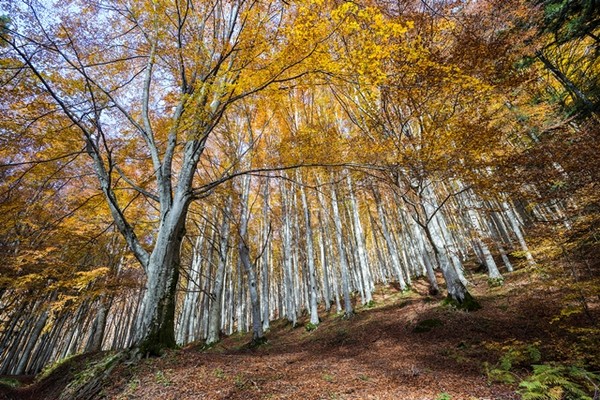
Forest Report: the potential and the critical issues
For the first time MIPAAF (the Italian Ministry for Agriculture, Food and Forestry Policies) has provided in a detailed report, a precise description of the Italian forest heritage and of the associated production chains. This work - unique for its completeness – is aimed at tracing the guidelines for sustainable production development of the woods, monitoring their evolution
On 21 March, on the occasion of the International Forestry Day, the Ministry of Agricultural Food and Forestry Policies and Tourism presented the first National Report on the State of Forests and forest-based sector in Italy (RaF Italia). 214 experts from national and regional bodies, institutions, administrations, and associations contributed to the realization of this articulated study, providing detailed information gathered in 8 focuses, 109 indicators, and 8 best practices. The aim of RaF Italia is to collect in a single tool the relevant knowledge and information concerning national forests and the connected supply chains, providing a clear picture of a sector to be exploited for the countless positive effects it can generate on the territory (environment and society). This paper will, therefore, make it easier to start a constant and new updating process for statistical surveys on this subject with a specific focus on the useful knowledge for national, European and international strategies. All this in accordance with the provisions of the recent Forests and Forestry-systems Single Text (Italian Legislative Decree N 34 of 3 April 2018) which aims to promote the protection of Italian forests in a productive way. The reading of the Report shows how the many stakeholders in the sector - first and foremost the Ministry itself - have well understood the opportunities for development in line with sustainability and traceability of the main supply chains, dynamically striking the right balance between conservation and enhancement. Forests, in fact, provide the community with ecosystem services of extraordinary value, which our country - among the first in the world - has managed to make explicit. In Italy, the quality of the products and the originality of the design have already made the processing chain a leader of a global market. According to Raoul Romano, a CREA researcher (Council for Agricultural Research and Economics) responsible for the forest file of the national rural network, our forests, which extend over more than a third of the entire national surface, feed a productive sector that employs over 400 thousand people. Improved management of the woods in terms of production and environmental and social services, could generate an additional 300,000 jobs, for rural areas in particular. Finally, much can still be done in terms of management of forests, increasing in a sustainable way our wood harvest to reduce wood imports from abroad, without affecting our natural capital. To this end, modern forest mechanization will play a central role, as it can contain the costs of cutting, extraction, and conditioning of biomass from stem wood or power, boosting the desired made in Italy timber revival. Another point not to be neglected is the high working quality and safety standards that innovative machinery can guarantee to operators.
The amount of data contained in the report has been summarized, for efficient dissemination, through an effective infographic associating the strengths, weaknesses and those to be developed in the sector with the colors of the traffic light (respectively green, red and orange).
Green traffic light
The Italian forest land is constantly increasing, but it is necessary to accompany this process with sustainable management to protect the woods and seizing the opportunities offered by the bio economy. Today the approximately 11 million hectares of forest represent 36.4% of the national territory, a rising trend that from 1936 to 2015 increased by 72.6%.
Despite the presence of large wooded areas, wood harvesting affects approximately 18-37% of biomass growth, these values well below the southern European average which goes around 62-67%.
The ecosystem services provided by forests are countless, and the attention with which we evaluate the beneficial effects associated with them is increasing. They range from recreational and cultural aspects - over 620,000 hikers enrolled in associations, 192 adventure parks, 71 nursery schools in the woods, etc. - up to the climatic aspects related to the capture of atmospheric CO2 to offset the climate-friendly emissions and generate incentives (about 2 million euros of transactions).
From an economic point of view, traditional forest processes (often reduced compared to the past and to the current potential for use) are associated with many new highly promising and highly sustainable productive sectors. Among these, for example green building, with the recent construction of about 1,130 wooden buildings for a value close to 700 million Euros, or even wood crops outside the forest that mark an increase in poplar plantations (now planted on 43.400 hectares) of 27% in the last five years, and an increase in their commercial value by 20% compared to 2016.
Orange traffic light
Although forest fires continue to be a problem, the areas affected tend to be reduced compared to the past. In fact, if in the thirty-year range from 1980 to 2009, the average extensions of the of wood damaged by the fire were of 116.533 hectares, and in the following seven years it fell to 72.621 hectares, only in 2017 the hectares were 162.363.
In 2016, the national silviculture - in particular in central and southern Italy - marked a growth in the number of companies in the sector reaching 6,471 (14% more than in 2011), compared with a decrease in the number of workers in the same period of time of 12,166, falling by 13.4%.
The interest in Sustainable Forest Management and Chain of Custody certifications is growing steadily, and the certified forest surface corresponds to 9% of the forests for 63,744 hectares (FSC) and 743,494 hectares (PEFC), the companies with CoC certification are 3,786.
The focus on the professional training of the operators is rising, especially in the forest companies of Northern Italy. However, unfortunately, there is still a widespread reluctance to adopt safety criteria while working in the forest. It should be noted that in the 21 Regions and P.A., only 10 have a training obligation for foresters. In this context, 1,774 injuries were recorded last year (23% less than in 2013) for an average incidence of 4.5 episodes per 100 workers.
Many of the Italian towns are rich in parks and gardens, but their function can be further improved by increasing the surfaces and optimizing the management also for better usability and safety. To date, 7.2% of the major urban centers are occupied by trees and each Italian has 27 square meters of green (9-11 square meters is the threshold of “good quality of life”).
Non-wood products such as mushrooms and truffles are of great interest, although we cannot have precise reference data on withdrawals and trade. On the other hand, the chestnut-growing and cork-growing sectors suffer from an ongoing difficult period. For example, the fruit chestnut groves - 42,719 hectares in 2016 – fell by 41% compared to 2010. Furthermore, for the transformation of cork, again in 2016, there were 217 active companies throughout the national territory (18.4% less than in 2011) for 1,718 workers (15.6% less than in 2011).
Red traffic light
The wood and timber market from abroad makes Italy a net importer of these resources because of the low national collection rates and lower labor costs in other countries. Suffice it to say that every year we import raw timber for 3.75 million of m3 and we export only 0.21 million of m3, while for semi-finished timber import reaches 14.46 Mm3 compared to export of little less than 2 million of m3.
The companies and those involved in the sector of the first wood processing (sawmills), also because of the economic crisis, are reducing in number and significantly decreasing the turnover. In 2016 there were 27,194 companies (25.9 fewer than in 2008), 103,543 workers (33,3 less than in 2008) and 12.9 million of euro in turnover (25.6 less than in 2008).








